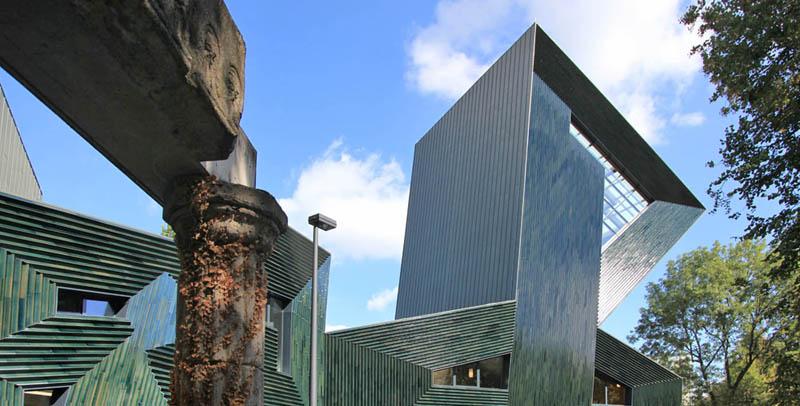Jewish community centre in Mainz

An expressive silhouette, an iridescent ceramic facade, the synagogue room with ornament relief made from Hebraic letters: the Jewish Community Centre from the architects Maunel Herz in Mainz, Germany, is a fascinating building that takes on a multilayered approach to the history of the Jewish community in Mainz and the meaning of the written word.
Architects: Manuel Herz Architekten, Basel, Switzerland
In the Wilheminian neighbourhood of Mainz’s new town, a sculptured building shimmers behind and through a row of trees: the Jewish community centre, reachable through the location of the main synagogue that was destroyed in 1938 during the infamous ‘Crystal Night’. In terms of urban development, the many bends and angles of the new building contrast with the perimeter block development. At the same time, an open area is created in front of the synagogue, which closes out the building’s body in the east through its lofty roof. Its expressive silhouette is inspired by the lettering »Keduschah«, the Hebraic word for exalt or blessing.
The font is literally used as a spatial element and typifies the larger meaning of the written word in the history of Judaism. The iridescent facade sheathing made from dark green ceramic elements surprises with a large number of shades that – depending on the light – go from almost black to reflecting silver. In concentric patterns around the window apertures, the triangle beams give a three-dimensional perspective to the wall surface.
The Synagogue - the spiritual centre of the building - is in itself a peaceful central room that is illuminated by an overhead light. The wall surface is covered with a plaster ornament relief made from Hebraic characters in a warm golden bronze tone. In certain places, the abstract pattern transforms into »Piyutim«, a middle aged religious sermon from Mainz’s rabbis. They tell the story of the beginning of the city as a centre for Jewish teachings and religion.
